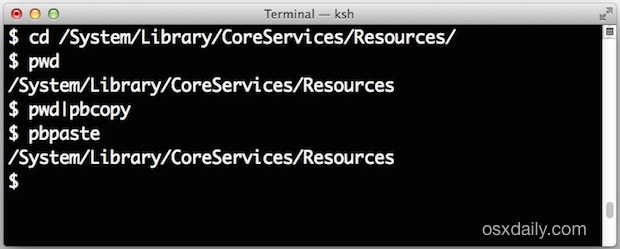
- #MAC COPY PATH TO TERMINAL HOW TO#
- #MAC COPY PATH TO TERMINAL CODE#
- #MAC COPY PATH TO TERMINAL MAC#
- #MAC COPY PATH TO TERMINAL WINDOWS#
You navigate the Terminal by using arrow keys. You cannot use your keyboard and mouse to navigate the Terminal. Therefore it’s important that you learn a few things that you should keep in mind when learning the Terminal. Navigating the Terminal might not be as straightforward as navigating a GUI application. Here, you can customize the appearance of the Terminal including the background color, text color, and font.

In the preferences menu, navigate to the Profiles tab. While on Terminal, navigate to ‘Terminal’ on the top bar and select Preferences. Changing the theme of the Terminal lets you do just that. First, it’s best if you adjust the appearance to fit you.
#MAC COPY PATH TO TERMINAL MAC#
Type in the word Terminal and click on the first suggestion.Įither of these two methods will bring up the Mac command prompt and it will look like a black box as below.ĭepending on your Terminal setting, the appearance may look different. Push command and space buttons together to bring up the Spotlight Search bar. In Finder, navigate to the location of the Terminal application which is:Īn alternate method is from Spotlight Search. There are several ways you can access Terminal. The Terminal application is in the Utilities folder in Applications. While you will not be a IT specialist right away by knowing your way around the Terminal, it’s the first step to becoming one - if that’s your goal. Once you grasp its basic functionality you can take on more complex tasks and when you do so, using the Terminal can be a lot of fun. It’s a quicker way of navigating the operating system, provided that you are familiar with the Terminal commands on Mac. While of course, it is not the case, knowing Mac Terminal commands will give you an upper hand in mastering the MacOS environment.Īs a Terminal emulator, it provides you with text-based access to the operating system. When using Terminal on Mac, it might look like you are trying to hack into a system. The second does what an Option-drag does, or what happens when you drag a file to a different disk or volume.Some MacOS users might be intimidated by the Terminal and its commands. The first does the same as dragging a file to a new location on the same hard disk.

There are two commands for moving and copying: mv and cp. The same is the case from the command line. (You may know that you can copy a file in the Finder, even on the same hard disk, by holding down the Option key when you drag it.) However, if you drag a file from your Desktop to an external hard disk, you’ll see that the file remains in its original location this file has been copied. The file is no longer on the Desktop, and is found only in the Documents folder. If you’re in the Finder, and you drag a file from, say, your Desktop to your Documents folder, or any other folder on the same disk or volume, you move the file. The difference between copying and moving files
#MAC COPY PATH TO TERMINAL WINDOWS#
#MAC COPY PATH TO TERMINAL HOW TO#
I’ll also show you how to create directories (that’s Unix-speak for folders), so you can move files to new places.


You’ve learned how to navigate files and folders as well as delete files and folders with the command line and get help when you need it from man pages. Here, I’ll show you how to copy and move files, common operations that often come in handy.
#MAC COPY PATH TO TERMINAL CODE#
The command line-that hidden world of code behind your Mac’s pretty face-sometimes offers a quicker way to do everyday tasks, plus it’s just a cool way to establish your tech cred.


 0 kommentar(er)
0 kommentar(er)
